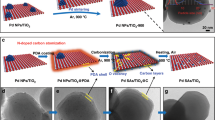Abstract
A simple and efficient approach based on microwave heating process was developed to prepare carbon supported nickel phosphide. In this approach, red phosphorus was used as a P source and carbon acted as both the support and the microwave absorbent. The red phosphorus was homogeneously mixed with Ni-impregnated carbon by milling, and then subjected to microwave heating. After several minutes by microwave heating in Ar or H2 atmosphere, the nickel phosphide, Ni2P, was produced on the carbon support, while the temperature of the sample bed was only 473 K or even lower during the reaction. It was also found that the preparation atmosphere had significant effects on the phosphide formation. Compared to the preparation in Ar, the nickel phosphides prepared in H2 were more readily formed and more highly dispersed on the carbon support due to PH3 formation during the reduction process. The as-prepared nickel phosphide catalysts exhibited much higher activities in selective hydrogenation of 1,3-butadiene compared to that prepared by the conventional heating method, which was attributed to the high dispersion of Ni2P prepared by the microwave heating method.
Graphical Abstract
We report a simple and efficient route to prepare activated carbon supported nickel phosphide via microwave heating. The whole synthesis time is less than 7 minutes, and the catalyst has a uniform particle size distribution and a high dispersion by microwave heating.







Similar content being viewed by others
References
Oyama ST (2003) J Catal 216:343
Wang H, Shu Y, Zheng M, Zhang T (2008) Catal Lett 124:219
Nozaki F, Tokumi M (1983) J Catal 79:207
Oyama ST, Wang X, Lee YK, Bando K, Requejo FG (2002) J Catal 210:207
Burns AW, Gaudette AF, Bussell ME (2008) J Catal 260:262
Wang X, Clark P, Oyama ST (2002) J Catal 208:321
Sawhill SJ, Phillips DC, Bussell ME (2003) J Catal 215:208
Sawhill SJ, Layman KA, Van Wyk DR, Engelhard MH, Wang C, Bussell ME (2005) J Catal 231:300
Wang A, Ruan L, Teng Y, Li X, Lu M, Ren J, Wang Y, Hu Y (2005) J Catal 229:314
Korányi TI, Vít Z, Poduval DG, Ryoo R, Kim HS, Hensen EJM (2008) J Catal 253:119
Li W, Dhandapani B, Oyama ST (1998) Chem Lett 3:207
Yang S, Prins R (2005) Chem Commun 33:4178
Yang S, Liang C, Prins R (2006) J Catal 237:118
**e Y, Su H, Qian X, Liu X, Qian Y (2000) J Solid State Chem 149:88
Aitken JA, Ganza-Hazen V, Brock SL (2005) J Solid State Chem 178:970
Barry BM, Gillan EG (2008) Chem Mater 20:2618
**ng G, Li W, Zheng M, Tao K (2009) J Catal 263:1
Perera SC, Tsoi G, Wenger LE, Brock SL (2003) J Am Chem Soc 125:13960
Hu X, Yu J (2008) Chem Mater 20:6743
Wang A, Qin M, Guan J, Wang L, Guo H, Li X, Wang Y, Prins R, Hu Y (2008) Angew Chem Int Ed 47:6052
Galema SA (1997) Chem Soc Rev 26:233
Zhu Y, Wang W, Qi R, Hu X (2004) Angew Chem Int Ed 43:1410
Panda AB, Glaspell G, El-Shall MS (2006) J Am Chem Soc 128:2790
Celer EB, Jaroniec M (2006) J Am Chem Soc 128:14408
Xu L, Ding Y, Chen C, Zhao L, Rimkus C, Joesten R, Suib SL (2008) Chem Mater 20:308
Yu J, Hu X, Li Q, Zhang L (2005) Chem Commun 21:2704
Yu J, Hu X, Li Q, Zhang Z, Xu Y (2005) Chem Eur J 12:548
Hu X, Yu J (2006) Chem Asian J 1:605
Liang C, Ding L, Wang A, Ma Z, Qiu J, Zhang T (2009) Ind Eng Chem Res 48:3244
Shu Y, Oyama ST (2005) Carbon 43:1517
Tang J, Zhang T, Liang D, Sun X, Lin L (2000) Chem Lett 8:916
Wang X, Wang A, Wang X, Zhang T (2007) Energy Fuels 21:867
Wang H, Shu Y, Wang A, Wang J, Zheng M, Wang X, Zhang T (2008) Carbon 46:2076
Boitiaux JP, Cosyns J, Vasudevan S (1983) Appl Catal 6:41
Moyes R, Well P, Grant J, Salman NY (2002) Appl Catal A Gen 229:251
Nozaki F, Adachi R (1975) J Catal 40:166
Acknowledgments
Supports from the Natural Science Foundation of China (NSFC Nos. 20573108, 20773124, 20773122) and from the National Basic Research Program of China (2009CB226102) are gratefully acknowledged.
Author information
Authors and Affiliations
Corresponding author
Rights and permissions
About this article
Cite this article
Ding, L., Zheng, M., Wang, A. et al. A Novel Route to the Preparation of Carbon Supported Nickel Phosphide Catalysts by a Microwave Heating Process. Catal Lett 135, 305–311 (2010). https://doi.org/10.1007/s10562-010-0280-9
Received:
Accepted:
Published:
Issue Date:
DOI: https://doi.org/10.1007/s10562-010-0280-9




